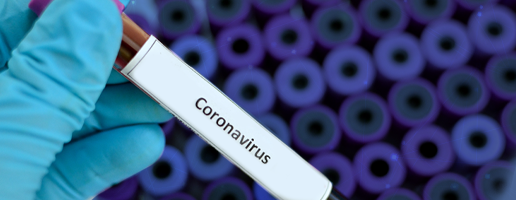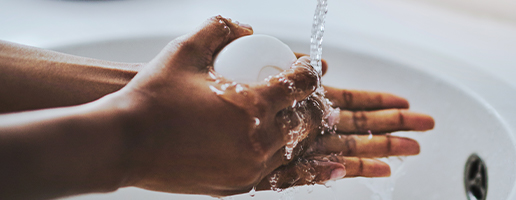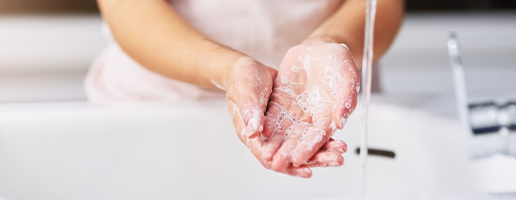Worried about how you feel when breathing through a face mask?

Are you worried about breathing well while wearing a face mask to contain the spread of COVID-19? Are you concerned about how a mask may affect your health? Dr Philippa Wheble and Dr Ela Manga (pictured) share all you need to know to calm your concerns.
To help contain the spread of coronavirus disease 2019 (COVID-19), wearing a mask is now compulsory in public spaces and in the workplace in many countries. However, many people have expressed concern about the impact of wearing a mask on their breathing and therefore on their physical and mental health.
Dr Philippa Wheble and Dr Ela Manga offer a conscious approach to breathing in relation to mask-wearing in this article.
The World Health Organization regularly updates its resources and materials based on new scientific findings as the epidemic evolves. It now recommends that people over 60 and anyone with underlying health conditions should wear medical-grade masks when they go out in public. Everyone else should wear cloth masks. For our most recent article on masks, read:
When breathing feels limited, difficult or scary, so does everything else
The COVID-19 pandemic has made the whole planet far more aware of people’s breathing. For many, this has caused a great deal of fear and anxiety. The virus itself attacks our respiratory system, making it hard to breathe – and when breathing feels limited, difficult or scary, so does everything else.
The way we breathe can affect our physical, mental and emotional wellbeing. These states can also change how we experience our breathing. It is well documented that chronic stress, anxiety, our posture and movement can all impact the mechanics and chemistry of our breathing. A practice of conscious breathing supports us in first becoming aware of our breathing behaviours and then shifting them, which empowers us to shift our mental and emotional states.
Why should we wear a mask?
COVID-19 is spread through respiratory droplets. Breathing, speaking, singing, laughing, coughing or sneezing can all push the virus into the air. The virus can travel in the air around one metre (further if you move fast, cough or sneeze), dropping and settling on anything with which it comes into contact. We know that we can get the virus on our hands by touching infected surfaces. We can also transfer the virus between surfaces by touching them with our contaminated hands. This is why we are all washing our hands and being mindful about the things that we touch.
A large percentage of people who are infected with the COVID-19 virus are asymptomatic and not aware that they are infectious. The rationale for wearing a mask in public is to limit the spread of the virus by preventing you from spreading it to other people. Wearing a mask also prevents you from touching your nose or mouth and infecting yourself with the virus that you may encounter while out and about.
Why is there concern about wearing a mask?
Some people report feelings of dizziness, fatigue and headaches while wearing a mask. While this phenomenon has not been formally researched, there could be various reasons for these experiences.
The ideal mask will allow for the easy flow of air (breathable) but will prevent the spread of droplets through it (impermeable). If your mask does not allow air to flow through it, this could have negative effects on your health and wellbeing.
But there are other reasons why you might get symptoms such as those mentioned, while wearing a mask:
- Wearing any mask can trigger a feeling of not getting enough air and cause you to breathe differently.
- If you are concerned about being outside and being at risk of getting the virus, you might breathe differently.
- If you are anxious or stressed, you will breathe differently.
- If you have the virus, you will breathe differently.
Typically, when we are worried or anxious, adrenaline causes us to take faster and shallower breaths. This leads to lower levels of carbon dioxide in the blood, which in turn can cause dizziness, fatigue, headaches, chest pain, breathlessness, numbness and tingling, a feeling of disorientation or confusion, and increased emotionality.
If your mask is adequately breathable, it is more likely that symptoms experienced relate to your own breathing rather than the mask itself.
Does my mask limit the amount of oxygen I get?
A myth-busting statement on the World Health Organization’s website reads: “The prolonged use of medical masks can be uncomfortable. However, it does not lead to CO2 intoxication nor oxygen deficiency.”
Medical-grade masks are specifically designed to offer high-level protection (impermeability) and adequate oxygenation (breathability) while doing highly skilled and high-risk tasks.
While the general public does not need medical-grade masks, manufactured and home-made masks should offer the same level of breathability and reasonable impermeability:
- A recent study done in Illinois, USA, showed that a mask made with double layered T-shirt material (cotton or cotton-polyester blends) balances the best breathability with a 98% impermeability to droplet spread – so a 98% droplet-blocking efficiency – which performs equally to medical masks.
- The only difference is that household materials will retain droplets rather than repel them, so it is important to wash with hot water (or dispose of) masks after each use.
Should I breathe through my nose or my mouth when wearing a mask?
Breathing through the nose provides the benefit of the air being moistened and filtered. Nasal breathing also produces nitric oxide (a molecule produced naturally by the body), which kills viruses and bacteria.
Breathing through the nose is preferable when wearing a mask.
How can I breathe better while wearing a mask?
Wearing a mask can be great training for conscious breathing. Take this opportunity to be mindful of your breathing, and seeing the mask as an extra filter.
- Breathe through your nose.
- Notice how your breathing changes in reaction to your experience and environment.
- Consciously take slower and deeper breaths if you feel overwhelmed.
- Add a drop of essential oil, such as peppermint or orange, to keep your airways feeling open and to bring sensory enjoyment.
- When you take your mask off, spend a few minutes taking some full conscious breaths or practise the box breathing technique to bring calm energy and balance back to your system.
- https://neurosciencenews.com/coronavirus-mask-material-16333/
- https://pubmed.ncbi.nlm.nih.gov/22168256
- Dr Ela Manga is an integrative medical doctor and leading voice in the field of mind-body medicine. She has dedicated her career to using breathing as medicine and as a tool for personal growth and transformation. Ela is a sought-after speaker, both locally and internationally, and has a revolutionary way of facilitating groups for profound transformation. She is the founder of Breathwork Africa and author of BREATHE: Strategising Energy in the Age of Burnout. She lives and works in Johannesburg, South Africa.
- Dr Philippa Wheble is a medical doctor, specialising in General Practice and Performing Arts Medicine in the UK and is a Certified Transformational Breath Facilitator and Trainer™. She is dedicated to the science and research of conscious breathing modalities and to improving breathwork education. Pippa is an international lecturer and public speaker, passionate about promoting mental health and resilience through conscious breathing. She is creating scientific articles and an online anatomy and physiology course for Breathworkers to support best practice in this evolving profession.
All medical information found on this website including content, graphics and images, is for educational and informational objectives only. Discovery Health publishes this content to help to protect and empower all South Africans by promoting a better understanding of COVID-19.
Find a healthcare professional near you
Find a doctor or hospital near you online or by using the Discovery app.
Related articles

Outbreak of the 2019 novel coronavirus
The 2019 novel coronavirus (2019-nCoV) has caused an outbreak of fatal respiratory illness first detected in Wuhan, China. This is a completely new strain with no vaccines available. The best way to prevent infection is to avoid being exposed to this virus.

Understand the Novel Coronavirus (COVID-19) and prevent infection
No country is immune to the spread of the Novel Coronavirus - officially named COVID-19 by the World Health Organization (WHO). The outbreak has reached pandemic proportions and been declared a global public health emergency.

Novel Coronavirus - wash your hands of the threat
As toddlers, we learnt to wash our hands. But, did we ever master the skill to the extent that is needed to wash pathogens off our hands, and save lives? Multiple studies show people don't wash their hands at the right times, in the right way or for the right amount of time. We contaminate the things and people we touch with the germs we carry on our hands.